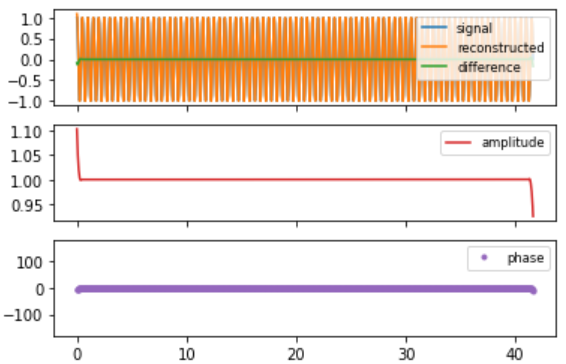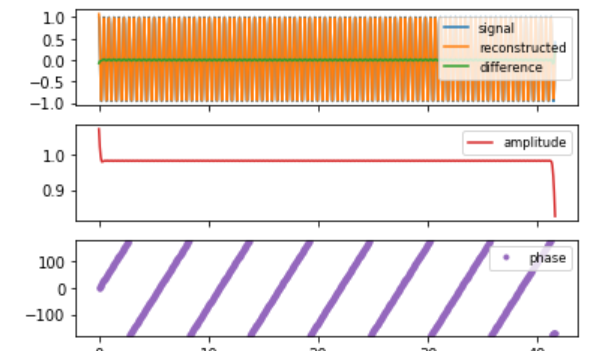复数解调相位和幅度图
复数解调相位图
在时间序列模型的频率分析中,常见的模型是正弦波:
![]()
其中,∝ 是幅度,phi 是相移,omega 是主频率。复数解调图的目标是改进频率估计。
由两部分组成的复数解调图:
- 纵轴:相位
- 横轴:时间
对频率进行良好初始估计的重要性:
正弦波的非线性拟合
![]()
上述方程对良好的初始值很敏感。频率ω的初始值可以通过频谱图获得。复数解调相位图用于评估此估计是否足够。如果估计不充分,那么是否应该增加和减少。
复数解调幅度图:
在时间序列模型的频率分析中,常见的模型是正弦波:
![]()
其中,∝ 是幅度,phi 是相移,omega 是主频率。
如果复数解调幅度图的斜率不为零,则上述方程最终由模型代替。
![]()
其中, a i是某种符合标准最小二乘法的线性模型。最常见的情况是线性拟合,即模型变成如下:
![]()
复数解调幅度图由下式构成
- 纵轴:振幅
- 横轴:时间
复振幅解调图回答了以下问题:
- 振幅会随时间变化吗?
- 是否有任何启动效应导致启动时振幅不稳定?
- 幅度是否有异常值?
执行:
代码:复杂解调分析的Python代码
python3
# code
import numpy as np
import matplotlib.pyplot as plt
def gen_test_data(periods, noise=0, rotary=False, npts=1000, dt=1.0/24):
"""
Generate a simple time series for testing complex demodulation.
*periods* is a sequence with the periods of one or more
harmonics that will be added to make the test signal.
They can be positive or negative.
*noise* is the amplitude of independent Gaussian noise.
*rotary* is Boolean; if True, the test signal is complex.
*npts* is the length of the series.
*dt* is the time interval (default is 1.0/24)
Returns t, x: ndarrays with the test times and test data values..
"""
t = np.arange(npts, dtype=float) * dt
if rotary:
x = noise * (np.random.randn(npts) + 1j * np.random.randn(npts))
else:
x = noise * np.random.randn(npts)
for p in periods:
if rotary:
x += np.exp(2j * np.pi * t / p)
else:
x += np.cos(2 * np.pi * t / p)
return t, x
def complex_demodulation(t, x, central_period, hwidth = 2):
"""
Complex demodulation of a real or complex series, *x*
of samples at times *t*, assumed to be uniformly spaced.
*central_period* is the period of the central frequency
for the demodulation. It should be positive for real
signals. For complex signals, a positive value will
return the CCW rotary component, and a negative value
will return the CW component (negative frequency).
Period is in the same time units as are used for *t*.
*hwidth* is the Blackman filter half-width in units of the
*central_period*. For example, the default value of 2
makes the Blackman half-width equal to twice the
central period.
Returns a dictionary.
"""
rotary = x.dtype.kind == 'c' # complex input
# Make the complex exponential for demodulation:
c = np.exp(-1j * 2 * np.pi * t / central_period)
product = x * c
# filter half-width number of points
dt = t[1] - t[0]
hwpts = int(round(hwidth * abs(central_period) / dt))
nf = hwpts * 2 + 1
x1 = np.linspace(-1, 1, nf, endpoint=True)
x1 = x1[1:-1] # chop off the useless endpoints with zero weight
w1 = 0.42 + 0.5 * np.cos(x1 * np.pi) + 0.08 * np.cos(x1 * 2 * np.pi)
ytop = np.convolve(product, w1, mode='same')
ybot = np.convolve(np.ones_like(product), w1, mode='same')
demod = ytop/ybot
if not rotary:
# The factor of 2 below comes from fact that the
# mean value of a squared unit sinusoid is 0.5.
demod *= 2
reconstructed = (demod * np.conj(c))
if not rotary:
reconstructed = reconstructed.real
if np.sign(central_period) < 0:
demod = np.conj(demod)
# This is to make the phase increase in time
# for both positive and negative demod frequency
# when the frequency of the signal exceeds the
# frequency of the demodulation.
d = {'t':t,'signal' : x,'hwpts' : hwpts,'demod': demod,'reconstructed' : reconstructed}
return d
def plot_demodulation(dm):
fig, axs = plt.subplots(3, sharex=True)
resid = dm.get('signal') - dm.get('reconstructed')
if dm.get('signal').dtype.kind == 'c':
axs[0].plot(dm.get('t'), dm.get('signal').real, label='signal.real')
axs[0].plot(dm.get('t'), dm.get('signal').imag, label='signal.imag')
axs[0].plot(dm.get('t'), resid.real, label='difference real')
axs[0].plot(dm.get('t'), resid.imag, label='difference imag')
else:
axs[0].plot(dm.get('t'), dm.get('signal'), label='signal')
axs[0].plot(dm.get('t'), dm.get('reconstructed'), label='reconstructed')
axs[0].plot(dm.get('t'), dm.get('signal') - dm.get('reconstructed'), label='difference')
axs[0].legend(loc='upper right', fontsize='small')
axs[1].plot(dm.get('t'), np.abs(dm.get('demod')), label='amplitude', color='C3')
axs[1].legend(loc='upper right', fontsize='small')
axs[2].plot(dm.get('t'), np.angle(dm.get('demod'), deg=True), '.', label='phase',
color='C4')
axs[2].set_ylim(-180, 180)
axs[2].legend(loc='upper right', fontsize='small')
for ax in axs:
ax.locator_params(axis='y', nbins=5)
return fig, axs
def test_demodulation(periods, central_period,
noise=0,
rotary=False,
hwidth = 1,
npts=1000,
dt=1.0/24):
t, x = gen_test_data(periods, noise=noise, rotary=rotary,
npts=npts, dt=dt)
dm = complex_demodulation(t, x, central_period, hwidth=hwidth)
fig, axs = plot_demodulation(dm)
return fig, axs, dm
# Example 1
test_demodulation([12.0/24], 12.0/24);
# Example 2
test_demodulation([11.0/24], 12.0/24)
示例 1:信号、幅度解调和相位解调

示例 2:信号、幅度解调和相位解调